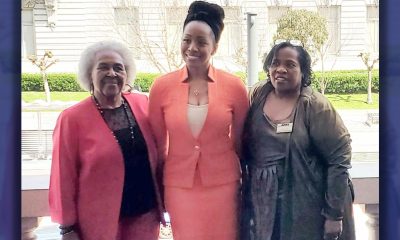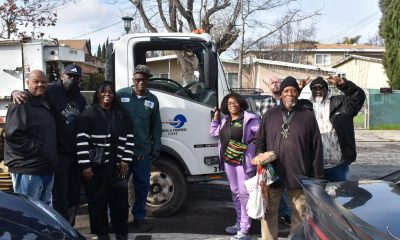#NNPA BlackPress
Three Years After #DefundThePolice, Schools Are Bringing Cops Back to Campus
SAN DIEGO VOICE & VIEWPOINT — As of January 2023, there were about 60 SROs remaining in D.C. schools, down from its peak of more than 100, according to the Washington Post. However, the progress made toward reducing law enforcement presence in D.C. schools appears to be in jeopardy. In what seems like a backtrack from the progressive momentum generated during “America’s racial reckoning,” four D.C. council members now support a proposal to retain officers in schools, citing an uptick in violence and crime in school vicinities.
The post Three Years After #DefundThePolice, Schools Are Bringing Cops Back to Campus first appeared on BlackPressUSA.

By
In the wake of George Floyd’s murder, calls to defund the police rang across the nation during the summer of 2020. While few cities took swift action, many school districts — integral community hubs where young minds are nurtured, and where kids spend the bulk of their time — began to reevaluate the presence of armed personnel patrolling the hallways.
In September 2019, eight months before Floyd’s murder, the Bureau of Justice Statistics reported nearly 25,000 school resource officers were assigned to primarily K-12 schools.
Those numbers slowly started to change in districts around the country as a response to calls to defund the police.
In Washington, D.C., for example, the D.C. Council unanimously voted in 2021 to reduce the number of SROs in both public and charter schools beginning July 2022, with the plan to end the Metropolitan Police Department’s School Safety Division in 2025.
In September 2019, eight months before Floyd’s murder, the Bureau of Justice Statistics reported nearly 25,000 school resource officers were assigned to primarily K-12 schools.
As of January 2023, there were about 60 SROs remaining in D.C. schools, down from its peak of more than 100, according to the Washington Post. However, the progress made toward reducing law enforcement presence in D.C. schools appears to be in jeopardy. In what seems like a backtrack from the progressive momentum generated during “America’s racial reckoning,” four D.C. council members now support a proposal to retain officers in schools, citing an uptick in violence and crime in school vicinities.
On the other side of the country, the Denver Public School District Board of Education unanimously voted to bring SROs back to schools through June 2023. Similar to D.C., the decision followed closely on the heels of a shooting at Denver’s East High School. And 18 SROs were brought back to 17 schools in the district.
Schools around the country are running into roadblocks trying to remove SROs.
The Roadblocks
The roadblocks don’t look the same in every situation.
In D.C., for example, ACLU DC policy associate Ahoefa Ananouko cites Mayor Muriel Bowser as the biggest barrier. Bowser has been vocal about keeping SROs in schools, going as far as to say that removing SROs is “the nuttiest thing.”
And, like in D.C. and Denver, politicians, policymakers, and some educators nationwide cite violence in the area as a reason for keeping SROs, but there is little evidence to support that SROs actually do make schools safer. In fact, in a 2020 report, the Justice Policy Institute said, “rates of youth violence were plummeting independent of law enforcement interventions, and the impact of SROs on school shootings has been dubious at best.”
Plus, it’s been proven that SROs exacerbate the school-to-prison pipeline, especially for Black students.
The Center for Public Integrity analyzed U.S. Department of Education data from all 50 states, D.C., and Puerto Rico in 2021. The investigation found that school policing disproportionately affects students with disabilities and Black students. Nationwide, these two groups were referred to law enforcement at “nearly twice their share of the overall student population.”
What we often have seen is that the teachers or classified staff who feel that it’s not within their ability to handle certain situations automatically defer to the SROs.
ADONAI MACK, SENIOR DIRECTOR OF EDUCATION AT CHILDREN NOW
But it doesn’t stop many adults on the school campus from differing discipline to SROs, says Adonai Mack, the senior director of education at Children Now. This happens when there is either a fear around addressing disciplinary problems or concerns, or feeling they aren’t able to handle it.
“What we often have seen is that the teachers or classified staff who feel that it’s not within their ability to handle certain situations automatically defer to the SROs,” Mack says.
This is where the call for additional non-police safety officials comes in, like nurses, counselors, or psychologists, who “certainly do more help than harm,” Mack says.
But, like teachers and other educators, there’s a shortage of these professionals. But Ananouko says this shouldn’t be a barrier if policymakers decided it was more important to have mental health professionals or restorative justice interventionalists — people who are trained to handle trauma, behavior, and underlying issues.
“I believe they could and should shift those resources to incentivize those professionals being hired instead of investing more in police,” Ananouko says, “which have been shown to be harmful to students in a school environment, generally.”
A Detriment to Mental Wellness
Though it’s too early to have concrete data on students’ mental health without SROs, there are, anecdotally, reasons to believe it’s a positive change.
Aside from students leading police-free school groups, there are other historic factors that lend insight. For one, whenever there are fears around deportation, not only Black students, but Latino and AAPI students experience negative mental health impacts, Mack says.
The feelings, like with the Defund the Police movement, are split across racial lines. Black, Latino, and AAPI students don’t always feel safe with police around.
“With kids of color, what you often have is this alienation,” Mack says. “There are decreased feelings of safety. Now, I would say that’s different for white kids and white families. They often will feel that having police on campus makes the campus safer.”
Black and Brown students are more likely to attend a school patrolled by an SRO.
And, Black and Brown students are more likely to attend a school patrolled by an SRO. A 2023 Urban Institute study found that schools where the student population is at least 80% Black and Brown, students are more likely to have an SRO compared to schools with a high population of white students, regardless of income levels. And, 34%-37% of schools with high populations of Black and Brown students have an SRO, compared to 5%-11% of predominantly white schools.
But it’s clear that there’s “a detriment to kids of color” with police on campus, Mack says.
“From that perspective, with any decrease, what we see is that it automatically improves the mental wellness of students from those communities,” Mack says.
‘A Critical Point’
While the roadblocks might be tougher or the headlines have fizzled out, Ananouko says the police-free schools movement “isn’t slowing down at all.”
And now, D.C. is at a critical point. It’s budget oversight season, meaning it’s the time when funding for SROs could be restored. But, every year since the initial 2021 vote, students, school administrators, teachers, and advocates have continued to push for the phase-out, Ananouko says.
“Our messaging has not changed,” Ananouko says. “We’ve stayed consistent in saying that police don’t keep students safe. And none of that has changed in these past three years.”
The bottom line is that all kids deserve to feel safe and nurtured, Ananouko says.
“They should be able to feel like they can go to school with that fear,” she says, whether this fear comes from other students or armed officers in the building who can use their gun “at any point at the discretion of the law is on their side.”
“A lot of the issues that students are dealing with are not going to be addressed by somebody with a gun.”
This article originally appeared in San Diego Voice and Viewpoint.
The post Three Years After #DefundThePolice, Schools Are Bringing Cops Back to Campus first appeared on BlackPressUSA.
#NNPA BlackPress
Beloved Actor and Activist Louis Cameron Gossett Jr. Dies at 87
NNPA NEWSWIRE — Louis Gossett Jr., the groundbreaking actor whose career spanned over five decades and who became the first Black actor to win an Academy Award as Best Supporting Actor for his memorable role in “An Officer and a Gentleman,” has died. Gossett, who was born on May 27, 1936, in Brooklyn, N.Y., was 87. Recognized early on for his resilience and nearly unmatched determination, Gossett arrived in Los Angeles in 1967 after a stint on Broadway.
The post Beloved Actor and Activist Louis Cameron Gossett Jr. Dies at 87 first appeared on BlackPressUSA.

By Stacy M. Brown
NNPA Newswire Senior National Correspondent
@StacyBrownMedia
Louis Gossett Jr., the groundbreaking actor whose career spanned over five decades and who became the first Black actor to win an Academy Award as Best Supporting Actor for his memorable role in “An Officer and a Gentleman,” has died. Gossett, who was born on May 27, 1936, in Brooklyn, N.Y., was 87. Recognized early on for his resilience and nearly unmatched determination, Gossett arrived in Los Angeles in 1967 after a stint on Broadway.
He sometimes spoke of being pulled over by law enforcement en route to Beverly Hills, once being handcuffed to a tree, which he remembered as a jarring introduction to the racial tensions of Hollywood. In his memoir “An Actor and a Gentleman,” Gossett recounted the ordeal, noting the challenges faced by Black artists in the industry. Despite the hurdles, Gossett’s talent shone brightly, earning him acclaim in groundbreaking productions such as “A Raisin in the Sun” alongside Sidney Poitier. His Emmy-winning portrayal of Fiddler in “Roots” solidified his status as a trailblazer, navigating a landscape fraught with racial prejudice.
According to the HistoryMakers, which interviewed him in 2005, Gossett’s journey into the limelight began during his formative years at PS 135 and Mark Twain Junior High School, where he demonstrated early leadership as the student body president. His passion for the arts blossomed when he starred in a “You Can’t Take It With You” production at Abraham Lincoln High School, catching the attention of talent scouts who propelled him onto Broadway’s stage in “Take A Giant Step.” His stellar performance earned him the prestigious Donaldson Award for Best Newcomer to Theatre in 1952. Though initially drawn to sports, Gossett’s towering 6’4” frame and athletic prowess led him to receive a basketball scholarship at New York University. Despite being drafted by the New York Knicks in 1958, Gossett pursued his love for acting, honing his craft at The Actors Studio under the tutelage of luminaries like John Sticks and Peggy Fury.
In 1961, Gossett’s talent caught the eye of Broadway directors, leading to roles in acclaimed productions such as “Raisin in the Sun” and “The Blacks,” alongside legends like James Earl Jones, Cicely Tyson, Roscoe Lee Brown, and Maya Angelou. Transitioning seamlessly to television, Gossett graced small screens with appearances in notable shows like “The Bush Baby” and “Companions in Nightmare.” Gossett’s silver screen breakthrough came with his role in “The Landlord,” paving the way for a prolific filmography that spanned over 50 movies and hundreds of television shows. From “Skin Game” to “Lackawanna Blues,” Gossett captivated audiences with his commanding presence and versatile performances.
However, his portrayal of “Fiddler” in Alex Haley’s groundbreaking miniseries “Roots” earned Gossett critical acclaim, including an Emmy Award. The HistoryMakers noted that his golden touch extended to the big screen, where his role as Sergeant Emil Foley in “An Officer and a Gentleman” earned him an Academy Award for Best Supporting Actor, making him a trailblazer in Hollywood history.
Beyond the glitz and glamour of Hollywood, Gossett was deeply committed to community activism. In 1964, he co-founded a theater group for troubled youth alongside James Earl Jones and Paul Sorvino, setting the stage for his lifelong dedication to mentoring and inspiring the next generation. Gossett’s tireless advocacy for racial equality culminated in the establishment of Eracism, a nonprofit organization dedicated to combating racism both domestically and abroad. Throughout his illustrious career, Gossett remained a beacon of strength and resilience, using his platform to uplift marginalized voices and champion social change. Gossett is survived by his children, Satie and Sharron.
The post Beloved Actor and Activist Louis Cameron Gossett Jr. Dies at 87 first appeared on BlackPressUSA.
#NNPA BlackPress
COMMENTARY: D.C. Crime Bill Fails to Address Root Causes of Violence and Incarceration
WASHINGTON INFORMER — The D.C. crime bill and so many others like it are reminiscent of the ‘94 crime bill, which produced new and harsher criminal sentences, helped deploy thousands of police and surveilling methods in Black and brown communities, and incentivized more states to build prisons through a massive infusion of federal funding. While it is not at the root of mass incarceration, it significantly accelerated it, forcing a generation of Black and brown families into a never-ending cycle of state-sanctioned violence and incarceration.
The post COMMENTARY: D.C. Crime Bill Fails to Address Root Causes of Violence and Incarceration first appeared on BlackPressUSA.

By Kaili Moss and Jillian Burford | Washington Informer
Mayor Bowser has signed the “Secure DC” omnibus bill passed by the D.C. Council last month. But we already know that this bill will be disastrous for all of D.C., especially for Black and brown residents.
While proponents claim that this legislation “will make D.C. residents safer and more secure,” it actually does nothing to address the root of the harm in the first place and instead maintains a cycle of violence, poverty, and broken community ties. The omnibus bill calls for increased surveillance, drug-free zones, and will expand pre-trial detention that will incarcerate people at a significantly higher rate and for an indeterminate amount of time before they are even tried. This bill will roll back decades of nationwide policy reform efforts and initiatives to keep our communities safe and whole, which is completely contradictory to what the “Secure” D.C. bill claims it will do.
What is unfolding in Washington, D.C., is part of a dangerous national trend. We have seen a resurrection of bad crime bills in several jurisdictions across the country — a phenomenon policy experts have named “zombie laws,” which are ineffective, costly, dangerous for communities of color and, most importantly, will not create public safety. Throwing more money into policing while failing to fund preventative measures does not keep us safe.
The D.C. crime bill and so many others like it are reminiscent of the ‘94 crime bill, which produced new and harsher criminal sentences, helped deploy thousands of police and surveilling methods in Black and brown communities, and incentivized more states to build prisons through a massive infusion of federal funding. While it is not at the root of mass incarceration, it significantly accelerated it, forcing a generation of Black and brown families into a never-ending cycle of state-sanctioned violence and incarceration. Thirty years later, despite spending billions each year to enforce these policies with many of these provisions remaining in effect, it has done very little to create long-term preventative solutions. Instead, it placed a permanent moving target on the backs of Black people, and the D.C. crime bill will do the same.
The bill calls for more pretrial detention. When our loved ones are held on pretrial detention, they are held on the presumption of guilt for an indeterminate amount of time before ever seeing a judge, which can destabilize people and their families. According to experts at the Malcolm Weimer Center for Social Policy at Harvard University, just one day in jail can have “devastating consequences.” On any given day, approximately 750,000 people are held in jails across the nation — a number that beats our nation’s capital population by about 100,000. Once detained, people run the risk of losing wages, jobs, housing, mental and health treatments, and time with their families. Studies show that pretrial detention of even a couple of days makes it more likely for that person to be rearrested.
The bill also endangers people by continuing a misguided and dangerous War on Drugs, which will not get drugs off the street, nor will it deter drug use and subsequent substance use disorders (SUDs). Drug policies are a matter of public health and should be treated as such. Many states such as Alabama, Iowa and Wisconsin are treating the current fentanyl crisis as “Crack 2.0,” reintroducing a litany of failed policies that have sent millions to jails and prisons instead of prioritizing harm reduction. Instead, we propose a simple solution: listen to members of the affected communities. Through the Decrim Poverty D.C. Coalition, community members, policy experts and other stakeholders formed a campaign to decriminalize drugs and propose comprehensive legislation to do so.
While there are many concerning provisions within the omnibus bill, car chases pose a direct physical threat to our community members. In July 2023, NBC4 reported that the D.C. Council approved emergency legislation that gave MPD officers the ability to engage in vehicular pursuits with so-called “limited circumstances.” Sgt. Val Barnes, the head of MPD’s carjacking task force, even expressed concern months before the decision, saying, “The department has a pretty strict no-chase policy, and obviously for an urban setting and a major metropolitan city, that’s understandable.” If our law enforcement officers themselves are operating with more concern than our elected officials, what does it say about the omnibus bill’s purported intention to keep us safe?
And what does it mean when the risk of bodily harm is posed by the pursuit itself? On Saturday, Feb. 10, an Eckington resident had a near-miss as a stolen car barreled towards her and her dog on the sidewalk with an MPD officer in pursuit. What responsibility does the city hold if this bystander was hit? What does restitution look like? Why are our elected officials pushing for MPD officers to contradict their own policies?
Just a few summers ago during the uprisings of 2020, we saw a shift in public perspectives on policing and led to legislation aimed at limiting police power after the highly-publicized murders of loved ones Breonna Taylor and George Floyd — both victims of War on Drugs policing and the powers gained from the ’94 crime bill. And yet here we are. These measures do not keep us safe and further endanger the health of our communities. Studies show that communities that focus on harm reduction and improving material conditions have a greater impact on public safety and community health. What’s missing in mainstream conversations about violent crime is the violence that stems from state institutions and structures that perpetuate racial and class inequality. The people of D.C. deserve to feel safe, and that includes feeling safe from the harms enacted by the police.
Kaili Moss is a staff attorney at Advancement Project, a national racial justice and legal organization, and Jillian Burford is a policy organizer at Harriet’s Wildest Dreams.
The post COMMENTARY: D.C. Crime Bill Fails to Address Root Causes of Violence and Incarceration first appeared on BlackPressUSA.
#NNPA BlackPress
Mayor, City Council President React to May 31 Closing of Birmingham-Southern College
THE BIRMINGHAM TIMES — “This is a tragic day for the college, our students, our employees, and our alumni, and an outcome so many have worked tirelessly to prevent,” Rev. Keith Thompson, chairman of the BSC Board of Trustees said in an announcement to alumni. “We understand the devastating impact this has on each of you, and we will now direct our efforts toward ensuring the smoothest possible transition for everyone involved.”
The post Mayor, City Council President React to May 31 Closing of Birmingham-Southern College first appeared on BlackPressUSA.

By Barnett Wright | The Birmingham Times
Birmingham-Southern College will close on May 31, after more than a century as one of the city’s most respected institutions.
“This is a tragic day for the college, our students, our employees, and our alumni, and an outcome so many have worked tirelessly to prevent,” Rev. Keith Thompson, chairman of the BSC Board of Trustees said in an announcement to alumni. “We understand the devastating impact this has on each of you, and we will now direct our efforts toward ensuring the smoothest possible transition for everyone involved.”
There are approximately 700 students enrolled at BSC this semester.
“Word of the decision to close Birmingham Southern College is disappointing and heartbreaking to all of us who recognize it as a stalwart of our community,” Birmingham Mayor Randall Woodfin said in a statement. “I’ve stood alongside members of our City Council to protect this institution and its proud legacy of shaping leaders. It’s frustrating that those values were not shared by lawmakers in Montgomery.”
Birmingham City Council President Darrell O’Quinn said news of the closing was “devastating” on multiple levels.
“This is devastating for the students, faculty members, families and everyone affiliated with this historic institution of higher learning,” he said. “It’s also profoundly distressing for the surrounding community, who will now be living in close proximity to an empty college campus. As we’ve seen with other institutions that have shuttered their doors, we will be entering a difficult chapter following this unfortunate development … We’re approaching this with resilience and a sense of hope that something positive can eventually come from this troubling chapter.”
The school first started as the merger of Southern University and Birmingham College in 1918.
The announcement comes over a year after BSC officials admitted the institution was $38 million in debt. Looking to the Alabama Legislature for help, BSC did not receive any assistance.
This past legislative session, Sen. Jabo Waggoner sponsored a bill to extend a loan to BSC. However, the bill subsequently died on the floor.
Notable BSC alumni include former New York Times editor-in-chief Howell Raines, former U.S. Sen. Howell Heflin and former Alabama Supreme Court Chief Justice Perry O. Hooper Sr.
This story will be updated.
The post Mayor, City Council President React to May 31 Closing of Birmingham-Southern College first appeared on BlackPressUSA.
-

 Activism4 weeks ago
Activism4 weeks agoOakland Post: Week of March 27 – April 2, 2024
-

 #NNPA BlackPress4 weeks ago
#NNPA BlackPress4 weeks agoCOMMENTARY: D.C. Crime Bill Fails to Address Root Causes of Violence and Incarceration
-

 #NNPA BlackPress4 weeks ago
#NNPA BlackPress4 weeks agoMayor, City Council President React to May 31 Closing of Birmingham-Southern College
-

 #NNPA BlackPress4 weeks ago
#NNPA BlackPress4 weeks agoBeloved Actor and Activist Louis Cameron Gossett Jr. Dies at 87
-

 Community1 week ago
Community1 week agoFinancial Assistance Bill for Descendants of Enslaved Persons to Help Them Purchase, Own, or Maintain a Home
-

 Activism3 weeks ago
Activism3 weeks agoOakland Post: Week of April 3 – 6, 2024
-

 Business1 week ago
Business1 week agoV.P. Kamala Harris: Americans With Criminal Records Will Soon Be Eligible for SBA Loans
-

 Activism2 weeks ago
Activism2 weeks agoOakland Post: Week of April 10 – 16, 2024



















































